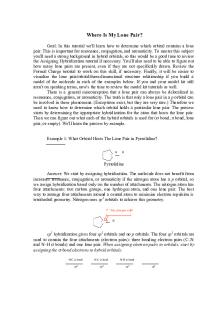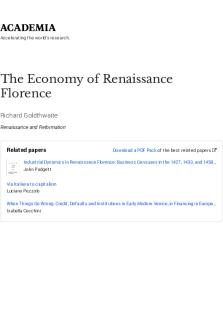Reading - Where the Counterculture Met the New Economy PDF

| Title | Reading - Where the Counterculture Met the New Economy |
|---|---|
| Course | Critical Internet Studies |
| Institution | University of Wisconsin-Madison |
| Pages | 2 |
| File Size | 50.2 KB |
| File Type | |
| Total Downloads | 68 |
| Total Views | 139 |
Summary
Reading - Where the Counterculture Met the New Economy...
Description
Where the Counterculture Met the New Economy - The WELL and the origins of virtual community 1960s: Stewart Brand came up with the idea for the “Whole Earth Catalog” - A book, a how-to manual, an encyclopedia, a literary review, life guide, recommendations/reviews - First catalog to win a national book award - Established a relationship between information technology, economic activity, and alternative forms of community that would outlast the counterculture itself and become a key feature of the digital world - Counterculture: the communalization of americans - shift from New Mexico to California (largest) - Members began arguing that interconnection could be the basis for a new social order - Non-Hierarchical, intimate, and free of bureaucratic mindset - Larry Brilliant - several items on the catalog could be put online - WELL: Whole Earth Lectronic Link - Began as a text-only environment but later turned into the first “network forum” - Depicted the products of an emerging counterculture and linked their members to one another - Catalog - 2 concepts 1. Boundary object - media formation around which individuals gathered and collaborated without relinquishing their attachment to their home networks 2. Trading zone - a place within which new networks were built, not only for social purposes but also for the purpose of accomplishing work - WELL - virtual community - Interactive possibilities of computer mediated communication - Translated countercultural vision of the proper relationship between technology and sociability into a resource imagining and managing life in the network economy - Community influence - Countercultural ideas regarding the relationship of technology to social life - “New left” - first civil rights movement - free speech - Sought to change the world through politics - “The counterculture” - second civil rights movement - cold war, zen buddhism, action painting, psychedelic drugs - Sought to change the conscious of individuals - The “New Communalists: society wanted to achieve the feeling of collectivity - small scale technologies (stereos/light kits at concerts/festivals) - Could be classified as “hippies” but the catalog still celebrating high technologies (not connected with hippies) - Linkage of the network of individuals and institutions → network forum - Informal representation of the larger community (information patterns)
-
-
-
From WEC to WELL - Brilliant approached Brand to make the well - Also founded “Network Technologies International” - sold computer conferencing systems - Hoped to allow the system’s users to converse with one another and to market that conversation back to its participants → subscription (cheaper) - Brand did not put the Catalog online but brought 2 essential features Rich mix of technical, countercultural politics, and journalistic communities - A management of ethos - Blend of countercultural politics and systems theory - Well-known journalists were given for free → increased the impact 7 design goals 1. Free (or as cheap as possible) 2. Profit making 3. Open-ended universe 4. Self-governing 5. Self-designing experiment 6. Community - reflected the nature of Whole Earth publications 7. Business users are main → wrong WELL and the Economy - Strength - possible to exchange smaller, time-sensitive pieces of information (data and technology about the computer and magazine industries) - WELL used to get information even though it is not a formal database - Capacity of information and experts → functioned as an encyclopedia - Strength - a contributor that stands out can be offered a job - Number of collaborations that have a huge impact on early culture of the public internet - David Stark - Heterarchy: the simultaneous mixture of motives and social contexts - Users abilities to characterize their postings as have value in social and economic registers - Depended on the computer technology of WELL and the cultural legacy of the New Communalist movement - Establishment of a countercultural ideal: a non hierarchically organized social form - Individuals are links by information technology and experience of shared mindset...
Similar Free PDFs

The Global Economy Notes
- 25 Pages

Where is the lone pair
- 6 Pages

Chapter 22 The Token Economy
- 9 Pages

The new British history
- 2 Pages

The New Food Fight
- 7 Pages

The Political Economy of Crisis
- 5 Pages

The new yorker - essay
- 2 Pages

The New Negro summary
- 6 Pages
Popular Institutions
- Tinajero National High School - Annex
- Politeknik Caltex Riau
- Yokohama City University
- SGT University
- University of Al-Qadisiyah
- Divine Word College of Vigan
- Techniek College Rotterdam
- Universidade de Santiago
- Universiti Teknologi MARA Cawangan Johor Kampus Pasir Gudang
- Poltekkes Kemenkes Yogyakarta
- Baguio City National High School
- Colegio san marcos
- preparatoria uno
- Centro de Bachillerato Tecnológico Industrial y de Servicios No. 107
- Dalian Maritime University
- Quang Trung Secondary School
- Colegio Tecnológico en Informática
- Corporación Regional de Educación Superior
- Grupo CEDVA
- Dar Al Uloom University
- Centro de Estudios Preuniversitarios de la Universidad Nacional de Ingeniería
- 上智大学
- Aakash International School, Nuna Majara
- San Felipe Neri Catholic School
- Kang Chiao International School - New Taipei City
- Misamis Occidental National High School
- Institución Educativa Escuela Normal Juan Ladrilleros
- Kolehiyo ng Pantukan
- Batanes State College
- Instituto Continental
- Sekolah Menengah Kejuruan Kesehatan Kaltara (Tarakan)
- Colegio de La Inmaculada Concepcion - Cebu







